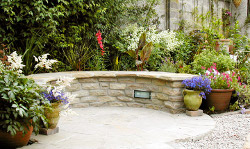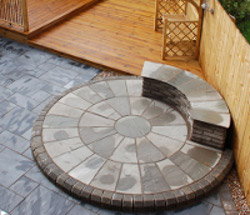Garden seating
Setting yourself down in your perfectly cultivated garden is a real treat,
so planning your
garden seating should be one of the first considerations
for a garden design project. They can greatly impact the layout and natural
path through the garden, as well as affecting where the majority of time
will be spent. A good seating area will be a focal point and draw the eye,
plus it should draw you to sit in it!
Know when and where your garden catches the sun
– if you want to sit in the
sun then your seating will need to be placed in the prime area for light
and the rest of the garden arranged around that point. Similarly, if you want
a respite from the heat of the sun, think about placing a seating area under
a tree or in a shady corner.
How many people will use it?
– This will always depend upon the size of the
garden, but you should generally provide numerous areas for seating
throughout the garden so that you’re never left standing and consider one
‘focal’ seating area supported by smaller seats as you move through the
garden.
Get into the garden – it can be very satisfying and exciting to integrate
your seat into, or facing, your planting beds so that you can really see the
wildlife close up. This works equally well for ponds – the closer you get
the more you’ll see!
 |
Incorporate seating where you can
– if you’re planning on making a patio,
using paving or building walls, consider incorporating a seat directly into
them using the same or complimentary materials.
It will help integrate
seating into the garden seamlessly and give a real feeling of solidity, and
often just an outcrop or jut of stone is required. |
If there’s too much of the same colour due to the materials you can
introduce contrasting colours into the planting, with small planters
placed to offset and draw attention. |
|
Think about materials – as well as using stone and your existing garden
materials, consider other looks.
Wooden seating can appear to ‘bed in’ to
the garden and surroundings easily, but ensure you choose the right wood and
stain to compliment the garden colours and planting schemes.
|
 |
Wicker and
rattan seating styles can provide a less ‘chunky’ look than wood and can
provide flexibility in that they’re easier to move.
More modern materials,
like aluminium, add a contemporary edge and are likely to stand out more due
to their reflective nature.
The image shows how different seating styles can
be made with juxtaposing materials (in this case wood and paving stone).
Finally, remember to make it comfortable! It’s generally difficult to find
really good cushioning to leave outdoors in the elements, so ensure you have
some nice cushions stored somewhere dry ready for those sunny,
out-in-the-garden days.
Copyright © 2000-2020
Hints and Things
All Rights Reserved.
No portion of this site may be reproduced or redistributed without prior written permission from Hints and Things. All trademarks &
copyrights throughout Hints and Things remain the property of their respective owners.
Hints and Things cannot be held responsible for any information given on this site nor do they
necessarily agree with, or endorse, the views given by third parties.


